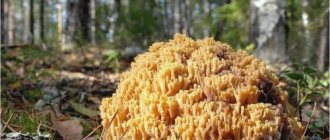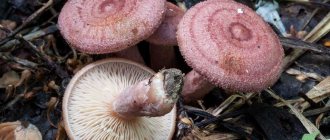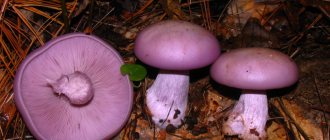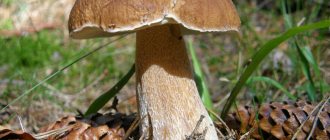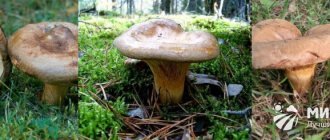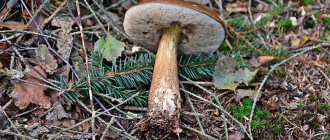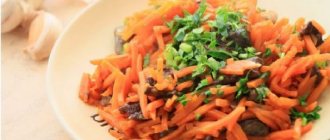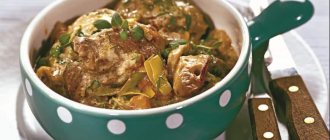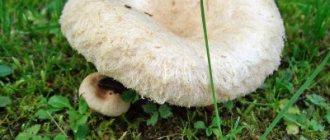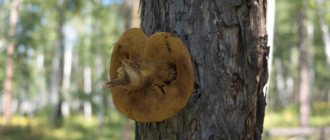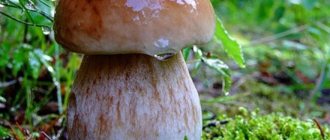Publication in the group: Dishes with mushrooms
Deer horns differ from other mushrooms in their color and unusual shape, similar to sea corals due to the large number of branches. “Silent hunters” in the forest often pass by, not knowing that many dishes are prepared from it, where the fruits, depending on the method of cooking, taste like shrimp or chicken.
General cooking principles
Edible deer horns, in addition to branches, have formations in the form of spines up to 2 cm long, the fruits can reach 20 cm in width, they do not have a pronounced mushroom aroma. Botanists note that the height almost always coincides with the height of the specimens. Body color changes with growth: young ones are light yellow, light brown and golden yellow, while older ones become bright orange.
If you break a young mushroom, the golden-white flesh will quickly change color to brown with a red tint. In an adult fetus, when pressing on the leg, it will be bright red.
Place of fruiting and time of collection
Deerhorns are mushrooms that grow in groups mainly in coniferous forests, but are also found in mixed deciduous forests in the northern and temperate zones of North America and Eurasia. This species loves damp, mossy areas and can be found in the middle and lower mountain zones. It can grow in large communities in arcs, rows, and form “witch rings.”
Only young yellow ramaria are collected, as adult mushrooms are very bitter. The “silent hunt” begins in August and ends in October, but in the southern regions it continues in winter. Due to the fragility of the fruits, it is better to take a basket with you, since in bags and bags all the fruits will become wrinkled and become unsuitable for consumption.
Doubles (false deer antlers)
Deer horns belong to the family of horned mushrooms, among which there are not only edible mushrooms, but also inedible ones. The latter will not lead to death, but poisoning and unpleasant consequences for the body will certainly be present. More often, inexperienced mushroom pickers collect beautiful ramaria, which can be distinguished by its pronounced red color when pressing on the fruit, and mushrooms on stumps. They are dangerous to health.
Benefits and harms
Deer horns are mushrooms widely used for medicinal purposes:
- Chinese traditional healers use them to treat the gastrointestinal tract and to improve the health of the lungs.
- Doctors say that this type of mushroom can strengthen the immune system and resist the development of tumors in the body.
- Bear's paw (another name for yellow ramaria) is used in folk medicine to get rid of parasites, helminths, and to treat joints by preparing infusions.
- In cosmetology they are used to slow down the aging process.
All these properties are inherent in deer antlers due to their composition, which contains lipids, beneficial amino acids, sterol, tryptophan and phytohemagglutinin.
Primary processing
The collected fruits should be processed immediately. To do this, first wash them thoroughly, removing debris between the branches. If the mushrooms are heavily soiled, you need to first soak them in cold water for 10 minutes.
After drying the deer horns on a towel or throwing them in a colander, you need to separate the ends, which will be very bitter in food. Then cut each specimen into pieces of approximately the same size. Boiling mushrooms takes at least 20-25 minutes, frying about 15 minutes. This type is used for preparing soups, main courses, gravies, and sauces. It is also suitable for harvesting for the winter. The fruits are pickled, salted or dried.
Botanical description
Staghorn mushrooms resemble coral branches or deer antlers in appearance. The photo shows a clear resemblance. The aboveground part of the plant is very branched and decorative. The spines are snow-white, 10 to 20 mm high. The body diameter of the mushroom is 16-30 cm; specimens weighing up to 1 kg are found in nature. It is worth noting that most often the height and width of the exotic mushroom are the same. The branches of the plant are thin and quite brittle. The coral hedgehog only affects the wireworm; other worms are indifferent to it.
The color of the mushroom changes as it grows, acquiring characteristic yellow shades. Obsolete copies may be bright orange. Horntails and amethyst colors grow. The active growing season of basidiomycetes falls from June to October. The biological culture does not have the usual mushroom aroma; in its raw form, the deer horn mushroom has an elastic consistency; when cooked, the fruiting body becomes harsh.
The most commonly mentioned mushrooms can be seen on tree trunks and stumps. Like other woody lower plants, they are not difficult to notice on rotten wood of any species. It is believed that among a certain variety of coral-shaped mushrooms there are no poisonous ones, while there are plants that are conditionally inedible and suitable for consumption. It is better to use young species of deer antlers for food. Large hedgehogs can disappoint with their taste: they are bitter and have an unpleasant aftertaste.
The best collection period is August and September; in the southern regions of our country, slingshots are also collected in winter. They often grow in whole clusters; collecting such mushrooms is an endless pleasure. Knowing the description of edible cattails, you can easily prepare the required amount of forest product and prepare wonderful dishes.
Mushroom soup
Soup with reindeer horns will taste significantly different from first courses with mushrooms.
Product set:
- water – 4 l;
- fresh mushrooms – 600 g;
- potatoes - 4 tubers;
- onions – 2 heads;
- garlic – 4 cloves;
- butter – 100 g;
- carrots – 1 pc.;
- bay leaf – 2 pcs.
Calorie content
| Calorie content | Squirrels | Fats | Carbohydrates |
| 27.6 kcal | 0.5 g | 1.7 g | 2.3 g |
You can replace fresh mushrooms with dried ones. But they will have to be pre-soaked for about 3 hours. Some housewives additionally add cereals (for example, millet) or pasta to the soup.
Step-by-step preparation:
- Divide the prepared deer horns without tips on the branches into pieces and boil for 15 minutes. in salted water.
- Drain the broth, discarding the mixture in a colander, and rinse again.
- Peel all the vegetables, rinse and chop: chop the onion into small cubes, potatoes and carrots into large pieces, and simply chop the garlic.
- Place the carrots and potatoes in a saucepan, add the specified amount of water and set over high heat.
- After boiling, reduce the flame and cook the mixture for 10-15 minutes.
- Heat a frying pan with butter. First, sauté the onion and garlic on it until the first is transparent, and then add the “coral” mushrooms and simmer the mixture for about another 3 minutes.
- Place the roast into a common pan, immediately add the bay leaf to the broth and cook for 10 minutes.
- After this time, add chopped herbs, cover with a lid and let brew for about 5-7 minutes.
Reindeer horns are mushrooms that can be used to make a delicious soup.
It is better to serve the soup hot or warm, inviting guests or family to add sour cream to it.
Similar species
Other yellowish horns have significant similarities with the deer horns mushroom:
- inedible blunt (Ramaria obtusissima), having rounded ends of the “twigs” and a bitter taste. It is found in Siberian mixed forests with the presence of fir and Far Eastern oak forests;
- conditionally edible yellow-brown (Ramaria flavobrunnescens), the height of which does not exceed 10 cm. With age, brown spots appear on mushrooms of this species;
- conditionally edible golden (Ramaria aurea), painted in a brighter ocher-yellow color, lighter towards the base;
- conditionally edible golden yellow (Ramaria lutea), smaller (up to 15 cm in height), found in the Primorsky Territory.
In addition, the inedible Calocera viscosa, which grows on stumps and dead wood, is often confused with deer horns. This mushroom has a bright egg-yellow color and dense gelatinous flesh.
Salad
Mushroom salad of deer legs with fresh cucumber is an unusual appetizer that saturates the body with useful substances.
Ingredients:
- chicken eggs – 2 pcs.;
- bell pepper – 1 fruit;
- deer horns – 300 g;
- fresh cucumber – 1 pc.;
- mayonnaise – 2 tbsp. l.;
- pepper and salt - to taste.
Calorie content
| Calorie content | Squirrels | Fats | Carbohydrates |
| 87.5 kcal | 4.1 g | 5.6 g | 4.1 g |
The dish will be less nutritious if you fill it with sour cream instead of mayonnaise. For a hearty snack, you can add boiled meat to the composition.
Step-by-step instruction:
- Carefully sort the mushrooms, wash them, cut off the ends of the branches and stems. Pour in enough water and boil until tender for 20 minutes, skimming the foam from the surface.
- Drain the deer horns in a colander, cool and divide into medium-sized pieces.
- In a separate bowl, hard boil the eggs, cool in ice water, peel and chop.
- Wash the cucumber under the tap, separate both ends and chop into half rings.
- Remove the stalk of the bell pepper along with the seed capsule, rinse and cut the pulp into thin strips.
- Combine all the prepared products in one cup and season with mayonnaise, not forgetting to add salt and pepper.
Serve the appetizer immediately, as after a while the cucumber will give juice and the dish will become unsightly.
Fried deer horns
More often, deer horns are used as the main ingredient in second courses. When fried, they are the most tender.
Compound:
- mushrooms – 500 g;
- onion – 1 pc.;
- refined oil – 3 tbsp. l.;
- salt, ground black pepper - to taste.
Calorie content
| Calorie content | Squirrels | Fats | Carbohydrates |
| 92.6 kcal | 2.3 g | 6.2 g | 5.8 g |
Deer horns can be cooked with potatoes, but it is better to first fry the vegetable and mushrooms separately over high heat, and then simmer together until the flame breaks down.
Cooking method:
- Sort the mushrooms, rinse well and place in a colander to drain all the water. Then divide them into pieces, throwing the ends of the branches aside.
- Remove the top layer from a small onion, rinse it and cut into thin half rings.
- Heat a thick-walled frying pan over high heat, heat refined oil in it.
- Place the vegetable first and sauté until translucent.
- Add the deer horns and continue to fry, stirring constantly.
- After about 15 min. Season the mixture with pepper and salt, cover with a lid, reduce the flame and leave on the stove for another 5 minutes.
You can serve mushrooms with a side dish of boiled potatoes, mashed potatoes, buckwheat porridge or pasta. It wouldn’t hurt to sprinkle the dish with fresh herbs and pour sour cream sauce over it.
Evaluation of taste, chemical composition, benefits and possible harm
Despite the fact that deer horns are classified as a fourth category mushroom due to the presence of a characteristic bitterness during the growth process, when young they are quite tasty and can be prepared in the same way as most other edible species.
Chemical composition per 100 grams of mushroom:
Average caloric content is 55 kcal per 100 g.
The benefits of yellow ramaria include the following qualities:
- Prevention of the appearance of malignant neoplasms.
- Relieving depression and normalizing mental state.
- Strengthening blood vessels, stabilizing the functioning of the cardiovascular system.
- Getting rid of diseases of the bronchopulmonary system and respiratory organs.
- Prevention of thrombosis, normalization of blood pressure.
- Boosting immunity.
- Cleansing the body, removing toxins and breakdown products.
The main area of application of yellow corals in cosmetology is anti-aging procedures. Deer horns have the ability to retain moisture in the epithelial layers; their effectiveness is several times greater than the properties of glycerin and hyaluronic acid. The natural polysaccharides contained in the chemical composition act as conductors of beneficial substances to the deep layers of the skin, and vitamin D activates metabolic processes.
Possible harm from consumption is also present. Like any other type of mushroom, yellow hornets are prohibited from being eaten by children under 12 years of age, pregnant and lactating women, people with chronic diseases of the gastrointestinal tract and a tendency to allergic manifestations.
Breaded
Reindeer horns fried in batter are suitable as an appetizer on a holiday table and for gatherings with friends.
Product set:
- wheat flour – 150 g;
- eggs – 2 pcs.;
- “coral” mushrooms – 450 g;
- granulated sugar – 10 g;
- salt – 15 g;
- vegetable oil – 2 tbsp. l.;
- water – 2 tbsp. l.;
- salt, spices - to taste.
Calorie content
| Calorie content | Squirrels | Fats | Carbohydrates |
| 153.9 kcal | 5.2 g | 6.5 g | 17.7 g |
In order for the mushrooms to have an airy, crispy crust after frying, the batter should be prepared by mixing unflavored sparkling water with potato starch to the desired consistency.
Preparation step by step:
- Boil the mushrooms, prepared in advance, adding a little salt to the water for 15 minutes.
- Place in a colander, let all the liquid drain and cool.
- Divide the deer horns into pieces and start preparing the batter.
- To do this, beat the eggs a little in a deep bowl, adding salt and granulated sugar.
- Then add the sifted flour and achieve uniformity of the composition.
- All that remains is to add water in small portions. A high-quality batter will coat the spoon in a small layer, leaving no empty spaces.
- Pick up a piece of mushroom with a fork, dip it completely into the prepared flour mixture and immediately place it in a frying pan heated with oil over high heat.
- Fry the deer legs on both sides until golden brown, and then place on napkins or a wire rack to remove excess fat.
This dish should be offered along with various sauces (sour cream with herbs and garlic, tomato with chopped herbs).
Gravy with sour cream
Deer horns are mushrooms from which you can prepare a low-calorie, but quite filling gravy for any side dish or pour it over a fried piece of meat.
Ingredients:
- fresh mushrooms – 600 g;
- garlic – 4 cloves;
- bell pepper – 3 pcs.;
- butter – 80 g;
- sour cream 20% – 150 ml;
- onions – 2 heads;
- salt pepper.
Calorie content
| Calorie content | Squirrels | Fats | Carbohydrates |
| 142.9 kcal | 2.7 g | 9.0 g | 12.3 g |
The gravy for this recipe will be thick. But it can be made more liquid if you add cream instead of sour cream or dilute it with a small amount of water.
Detailed recipe:
- Wash the deer horns, divide into medium pieces and boil in salted water for 20 minutes, drain in a colander.
- Peel, wash and chop the vegetables into cubes of the same size.
- Heat a frying pan, melt butter in it.
- Place the mushrooms in the bowl first and evaporate all the moisture. This usually takes about 3 minutes.
- Then add onions into the pan, and after 5 minutes. and bell pepper. Fry the ingredients, continuously stirring the mixture with a spatula.
- All that remains is to add room temperature sour cream to it, add pepper, salt, achieve homogeneity and simmer over low heat under the lid for literally 5 minutes.
First place the prepared side dish or meat on plates, and spread the mushroom sauce on top. You can decorate the dish with fresh vegetables or herbs.
Marinated mushrooms
If you managed to collect a large number of deer antlers in the forest, you can pickle them to enjoy their taste in the winter.
Product set:
- mushrooms – 2000 g;
- acetic acid 9% – 250 ml;
- dried dill – 10 g;
- cinnamon – 1 stick;
- water – 250 ml;
- sugar – 20 g;
- salt – 60 g;
- bay leaf – 4 pcs.;
- black pepper – 5 peas.
Calorie content
| Calorie content | Squirrels | Fats | Carbohydrates |
| 46.8 kcal | 2.1 g | 1.2 g | 5.5 g |
Sometimes the recipe uses sunflower oil, which is poured over the mushrooms already in jars. But you will first need to heat it well in a thick-walled frying pan to get rid of pathogenic microflora.
The recipe is given step by step:
- Sort the collected mushrooms, rinse, changing the water several times and place in a colander to get rid of any remaining moisture.
- Cut off the tops of the branches, the tips of the stems and cut into pieces or separate with your hands.
- Place an enamel bowl with the specified amount of water on the fire, immediately add vinegar, salt, granulated sugar and bring to a boil.
- Place the prepared deer horns into the marinade and cook for 15 minutes, lowering the flame.
- Literally in 5 minutes. add garlic, previously peeled and cut into slices, cinnamon, bay leaf and black pepper.
- Prepare glass jars by washing them with soda solution and sterilizing them in a convenient way (in the oven, over steam).
- Distribute the pickled mushrooms while hot and seal tightly with tin lids.
- Place the dishes upside down, cover with a warm blanket and cool completely to room temperature.
The appetizer can simply be seasoned with sunflower oil and served or used to prepare original salads.
Rogatik
Rogatik, or as they are also called horned mushrooms, belong to the family of basidiomycetes.
They have a fruit body of fleshy consistency. They are coral-branched, club-shaped and awl-shaped. The most common color is white with a yellow tint. Completely covered with a spore-bearing smooth layer. You can find such a crop in the forest on the soil; less often they are found on wood residue. They are not poisonous. Rogatiki have a large variety and germinate in large quantities, we just sometimes don’t pay attention to them. Many mushroom pickers pass by. This may be correct, because unfamiliar plants can be poisonous, but some cattails are quite edible. Even if you pick such an unfamiliar mushroom, you will not get poisoned, the only thing is that you will ruin your dinner, since some types have a specific taste.
Rogatik is a very curious representative of the mushroom kingdom. It plays a big role in the life of the forest. It is also a close relative of chanterelle mushrooms, and as you know, chanterelles can improve human health.
Assorted vegetables with mushrooms for the winter
This preparation with vegetables can be widely used: as an appetizer, side dish, or to complement the taste of boiled potatoes and pasta.
Product set:
- eggplants – 3 fruits;
- yellow ramaria – 1000 g;
- carrots – 2 pcs.;
- onion – 2 heads;
- zucchini – 700 g;
- bell pepper – 500 g;
- vegetable oil – 150 ml;
- apple cider vinegar – 50 ml;
- salt – 1 tbsp. l.;
- nutmeg – 1 pinch.
Calorie content
| Calorie content | Squirrels | Fats | Carbohydrates |
| 69.3 kcal | 1.4 g | 4.7 g | 5.0 g |
Step-by-step recipe:
- Prepare the mushrooms by sorting them, rinsing them and dividing them into pieces. Boil the reindeer horns for 10 minutes. twice, changing the water and salting the composition a second time.
- Drain the fruits in a colander and leave for about 20 minutes.
- At this time, peel all the vegetables, rinse and chop: it is better to chop the onion into small cubes, and give the rest of the fruits the appearance of large strips.
- Place the eggplant in another bowl, sprinkle with salt to remove the bitterness.
- In a frying pan heated with half the oil, sauté the onions and mushrooms and place the mixture in a large enamel bowl.
- Fry the remaining vegetables next and send to the deer horns, mix the products until smooth.
- Add salt, apple cider vinegar and nutmeg to the mixture and mix again.
- Distribute the mixture into clean glass jars, which are sterilized in simmering water for 10 minutes.
- Roll up the dishes, check that no air gets inside, and cool under a blanket at room temperature.
It is better to store the snack in a cool place and open it immediately before consumption.
How to salt reindeer horns
Deer horns are mushrooms suitable for salting. Experts advise not to use additional spices in the recipe, so as not to interrupt the delicate taste.
Ingredients:
- collected mushrooms – 2000 g;
- coarse non-iodized salt – 100 g
Calorie content
| Calorie content | Squirrels | Fats | Carbohydrates |
| 48.6 kcal | 2.5 g | 1.4 g | 5.2 gS |
Step-by-step preparation:
- The mushrooms will not be cooked during cooking. Therefore, it is necessary to sort and wash them more thoroughly, paying special attention to the places between the branches where needles often remain.
- Now separate all the ends from the legs and branches, rinse again and leave in a colander for at least 2 hours so that all the water runs out.
- Spread the harvest on a towel and dry additionally.
- Prepare stainless steel or enamel-coated utensils by rinsing them thoroughly and drying them with a clean towel.
- Sprinkle a small layer of salt on the bottom and place reindeer horns 3 cm high on top. Repeat the steps until all the ingredients are gone (salt should be on top).
- Cover the mushrooms with gauze, place a wooden board and set the weight.
- Leave on the counter at room temperature for 5 days, and when enough juice appears at the bottom, transfer the mushrooms to sterilized jars.
- Place the dishes in a cool place (ideal temperature 5-7°C).
- The delicacy will be ready for consumption after 1.5-2 months.
To serve, simply place the mushrooms in a deep plate, add chopped herbs and pickled onions, cut into thin half rings. Pour vegetable oil over everything and place on the table. This product can also be simply soaked a little in water and then used to prepare hot dishes.
What are “horns”
This is the second name by which the “deer horns” mushroom is known. It is also often called coral, and it’s clear why. It can grow to weigh up to a kilogram, so it can feed an entire family on its own. For some reason, worms avoid “horns,” so you shouldn’t expect any disappointments on this side. Their smell is quite attractive, with the exception of very old “individuals”. There are no poisonous imitators of the mushroom in nature, which is also nice. It is impossible to confuse them with something unsuitable for food - for this we must thank the non-standard appearance that “deer horns” have. How to cook mushrooms is also not difficult to understand: all the recipes for the bulk of their forest counterparts are also suitable for “horned mushrooms”.
Useful tips and tricks
A few recommendations for collecting deer antlers and using them in cooking:
- If you have no experience in picking mushrooms, then you need to take with you a person who understands their types.
- You cannot conduct “silent hunting” in places where industrial production is nearby, near roads and cities, in environmentally hazardous areas. Any mushrooms, even edible ones, become dangerous when they absorb harmful substances.
- Having collected a large number of deer antlers, you can not only marinate and salt them. They are great for drying. To do this, it is enough to disassemble the fruits into branches, stretch the thread through part of the stem and hang the garlands away from sunlight in a ventilated place.
Like any mushrooms, after cooking, reindeer horns must be stored in the refrigerator if the dish is not eaten at once. Do not eat food if there are any signs of spoilage (unpleasant taste and aroma, slimy consistency and the appearance of mold).
Description
Deer horns (Ramaria flava), a branched yellowish conditionally edible mushroom, is also called bear's paw and yellow coral.
It is characterized by the following distinctive features:
- the total height of the fruiting body reaches 20 cm, the maximum diameter is also 20 cm. The color, initially cream, yellowish, lemon or sulfur-yellow, eventually becomes ocher to orange. The flattened “branches” are repeatedly split in a U- or V-shape, have equal lengths, and somewhat blunt ends;
- the leg grows up to 8 cm in length and 5 cm in thickness. It is colored in shades of yellow characteristic of the entire mushroom, becoming lighter towards the base. In places of pressure it becomes reddish-brown;
- pale ocher spores are formed on the outer surface of the fruiting body;
- fragile pulp of watery consistency, light, yellowish, with a faint pleasant odor. As it ripens, it becomes bitter, especially in the “branches”.
